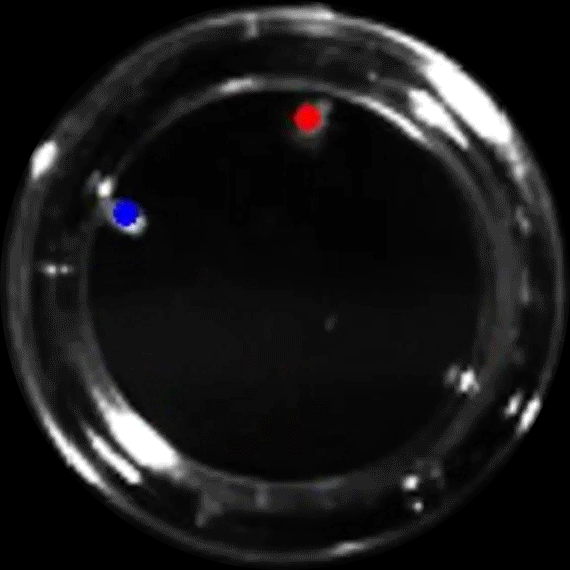RIKEN Center for Brain Science Laboratory for Circuit Mechanisms of Sensory Perception
Laboratory Head: Hokto Kazama (Ph.D.)
Research Summary

Animals decide and act based on past and current sensory information. The major goal of our lab is to mechanistically understand how neural processing of external input guides behavior and how this processing is modulated depending on the environmental and behavioral contexts.
To achieve this goal, we are using the fruit fly Drosophila melanogaster, which has been increasingly recognized as one of the ideal organisms for investigating the neural circuit basis of behavior. Due to the relatively small number of central neurons, many neurons in the fly brain are identifiable and accessible. We can monitor the responses of these neurons to sensory stimuli by in vivo electrophysiology and imaging. Various genetic tools are available for not only labeling but also manipulating neurons. On the other hand, technologies have been developed to monitor individual flies behaving in a virtual environment where external stimuli can be precisely controlled online. With these data in hand, we will utilize quantitative modeling approaches to better understand the computation and the neural mechanisms underlying behavior at cellular, synaptic and circuit levels.
Main Research Fields
- Complex Systems
Related Research Fields
- Biological Sciences
Keywords
- Sensory processing
- Decoding
- Neural circuits
- Sensorimotor transformation
Selected Publications
- 1.
Endo, K., Tsuchimoto, Y., Kazama, H.:
"Synthesis of conserved odor object representations in a random, divergent-convergent network."
Neuron 108, (2020). 10.1016/j.neuron.2020.07.029 - 2.
Shiozaki, H.M., Ohta, K., Kazama, H.:
"A multi-regional network encoding heading and steering maneuvers in Drosophila."
Neuron 106, 126-141 (2020). 10.1016/j.neuron.2020.01.009 - 3.
Ando, T., Sekine, S., Inagaki, S., Misaki, K., Badel, L., Moriya, H., Sami, M.M., Chihara, T., Kazama, H., Yonemura, S., Hayashi, S.:
"Nanopore formation in the cuticle of the insect olfactory sensillum."
Current Biology 29, 1512-1520 (2019). 10.1016/j.cub.2019.03.043 - 4.
Fujisawa, S., Kazama, H.:
"Circuits and neural dynamics underlying behavior."
Neuroscience Research 140, 1-2 (2019). 10.1016/j.neures.2019.01.002 - 5.
Mercier, D., Tsuchimoto, Y., Ohta, K., Kazama, H.:
"Olfactory landmark-based communication in interacting Drosophila."
Current Biology 28, 2624-2631 (2018). 10.1016/j.cub.2018.06.005 - 6.
Takagi, S., Cocanougher, B.T., Niki, S., Miyamoto D., Kohsaka, H., Kazama, H., Fetter, R.D., Truman, J.W., Zlatic, M., Cardona, A., Nose, A.:
"Divergent connectivity of homologous command-like neurons mediates segment-specific touch responses in Drosophila."
Neuron 96, 1373-1387 (2017). 10.1016/j.neuron.2017.10.030 - 7.
Shiozaki, H.M. and Kazama, H.:
"Parallel encoding of recent visual experience and self-motion during navigation in Drosophila."
Nature Neuroscience 20, 1395-1403 (2017). 10.1038/nn.4628 - 8.
Inada, K., Tsuchimoto, Y., Kazama, H.:
"Origins of cell-type-specific olfactory processing in the Drosophila mushroom body circuit."
Neuron 95, 357-367 (2017). 10.1016/j.neuron.2017.06.039 - 9.Badel, L., Ohta, K., Tsuchimoto, Y., Kazama, H.:
"Decoding of context-dependent olfactory behavior in Drosophila."
Neuron 91, 155-167 (2016). 10.1016/j.neuron.2016.05.022 - 10.
Kazama H.:
"Systems neuroscience in Drosophila: conceptual and technical advantages."
Neuroscience 296, 3-14 (2015). 10.1016/j.neuroscience.2014.06.035
Recent Research Results

Aug. 19, 2020
Constructing odor objects in the brain
Apr. 19, 2019
Flies smell through a gore-tex system
Aug. 3, 2018
Fecal deposits reveal the fruit fly’s pheromone flag
Related Links
Lab Members
Principal investigator
- Hokto Kazama
- Laboratory Head
Core members
- Yoshiko Takagi
- Research Scientist
- Keita Endo
- Research Scientist
- Damien Mercier
- Research Scientist
- Hongping Wei
- Special Postdoctoral Researcher
- kazumi Ohta
- Technical Staff I
- Ayaka Kato
- Junior Research Associate
Contact Information
2-1 Hirosawa, Wako, Saitama 351-0198, Japan
Email: hokto.kazama [at] riken.jp
